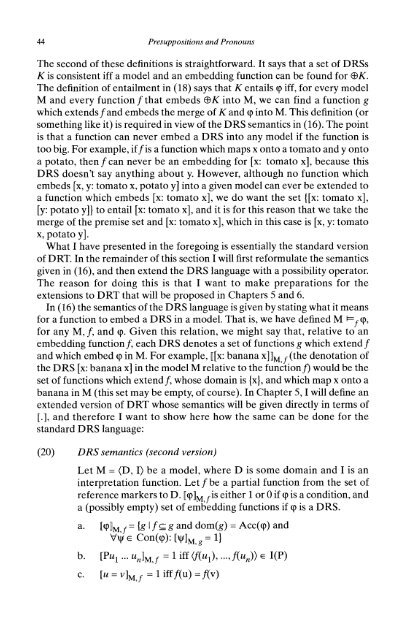Presuppositions and Pronouns - Nijmegen Centre for Semantics
Presuppositions and Pronouns - Nijmegen Centre for Semantics
Presuppositions and Pronouns - Nijmegen Centre for Semantics
You also want an ePaper? Increase the reach of your titles
YUMPU automatically turns print PDFs into web optimized ePapers that Google loves.
44 <strong>Presuppositions</strong> <strong>and</strong> <strong>Pronouns</strong><br />
The second of these definitions is straight<strong>for</strong>ward. It says that a set of DRSs<br />
K is consistent iff a model <strong>and</strong> an embedding function can be found <strong>for</strong> ~K. ®K.<br />
The definition of entailment in (18) says that K entails 9 q> iff, <strong>for</strong> every model<br />
M <strong>and</strong> every function / that embeds ~K ®K into M, we can find a function g<br />
which extends/<strong>and</strong> / embeds the merge of K <strong>and</strong> 9 q> into M. This definition (or<br />
something like it) is required in view of the DRS semantics in (16). The point<br />
is that a function can never embed a DRS into any model if the function is<br />
too big. For example, if/is a function which maps x onto a tomato <strong>and</strong> y onto<br />
a potato, then/can / never be an embedding <strong>for</strong> [x: tomato x], because this<br />
DRS doesn't say anything about y. However, although no function which<br />
embeds [x, y: tomato x, potato y] into a given model can ever be extended to<br />
a function which embeds [x: tomato x], we do want the set {[x: tomato x],<br />
[y: potato y]} to entail [x: tomato x], <strong>and</strong> it is <strong>for</strong> this reason that we take the<br />
merge of the premise set <strong>and</strong> [x: tomato x], which in this case is [x, y: tomato<br />
x, potato y].<br />
What I have presented in the <strong>for</strong>egoing is essentially the st<strong>and</strong>ard version<br />
of DRT. In the remainder of this section I will first re<strong>for</strong>mulate the semantics<br />
given in (16), <strong>and</strong> then extend the DRS language with a possibility operator.<br />
The reason <strong>for</strong> doing this is that I want to make preparations <strong>for</strong> the<br />
extensions to DRT that will be proposed in Chapters 5 <strong>and</strong> 6.<br />
In (16) the semantics of the DRS language is given by stating what it means<br />
<strong>for</strong> a function to embed a DRS in a model. That is, we have defined M 1=^-9, F= fq>,<br />
<strong>for</strong> any M, /, <strong>and</strong> q>. 9. Given this relation, we might say that, relative to an<br />
embedding function/, each DRS denotes a set of functions g which extend/<br />
<strong>and</strong> which embed q> 9 in M. For example, [[x: banana x]]M,f(the M /. denotation of<br />
the DRS [x: banana x] in the model M relative to the functionj) function/) would be the<br />
set of functions which extend/, whose domain is {x}, <strong>and</strong> which map x onto a<br />
banana in M (this set may be empty, of course). In Chapter 5,1 I will define an<br />
extended version of DRT whose semantics will be given directly in terms of<br />
[.], I.], <strong>and</strong> there<strong>for</strong>e I want to show here how the same can be done <strong>for</strong> the<br />
st<strong>and</strong>ard DRS language:<br />
(20) DRS semantics (second version)<br />
Let M = (D, I) be a model, where D is some domain <strong>and</strong> I is an<br />
interpretation function. Let / be a partial function from the set of<br />
reference markers to D. [q>]M,fis M ,is either lor 1 0 if 9 q> is a condition, <strong>and</strong><br />
a (possibly empty) set of embedding functions if q> 9 is a DRS.<br />
a. [q>]M,f= [cp] M f = {g I / c ~ g <strong>and</strong> dom(g) = Acc(9) Acc(q» <strong>and</strong><br />
V'I' Vxj/e E Con(9):[\|/] q»: ['I']M, M;g g = =l} I}<br />
b. [PU Ml 1<br />
... Un]M,f uJ Mt/ = 1 iff (j(u > ,/(u n ) E e I(P)<br />
c. [u[ M = v]M,f M/ =liff/(u)=/(v)<br />
= 1 = lev)














